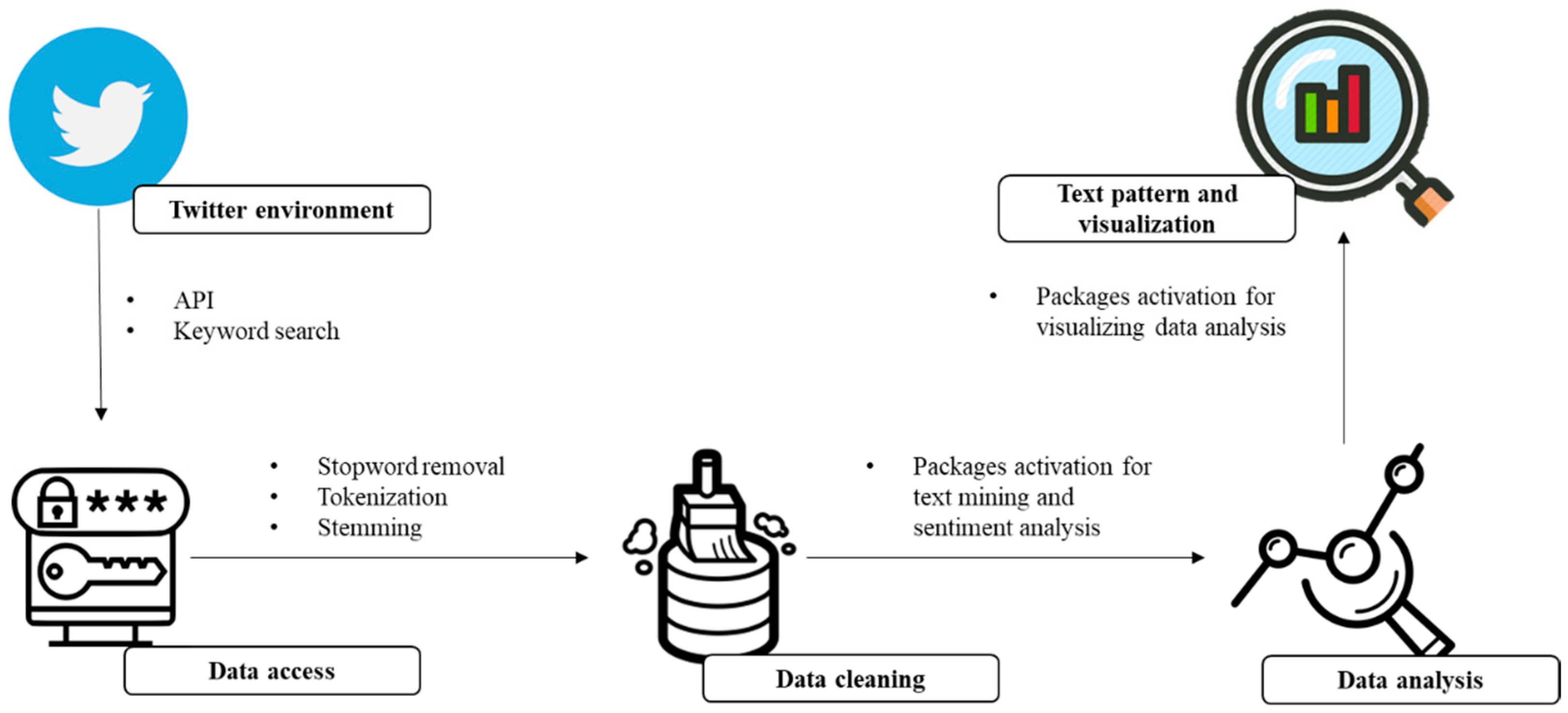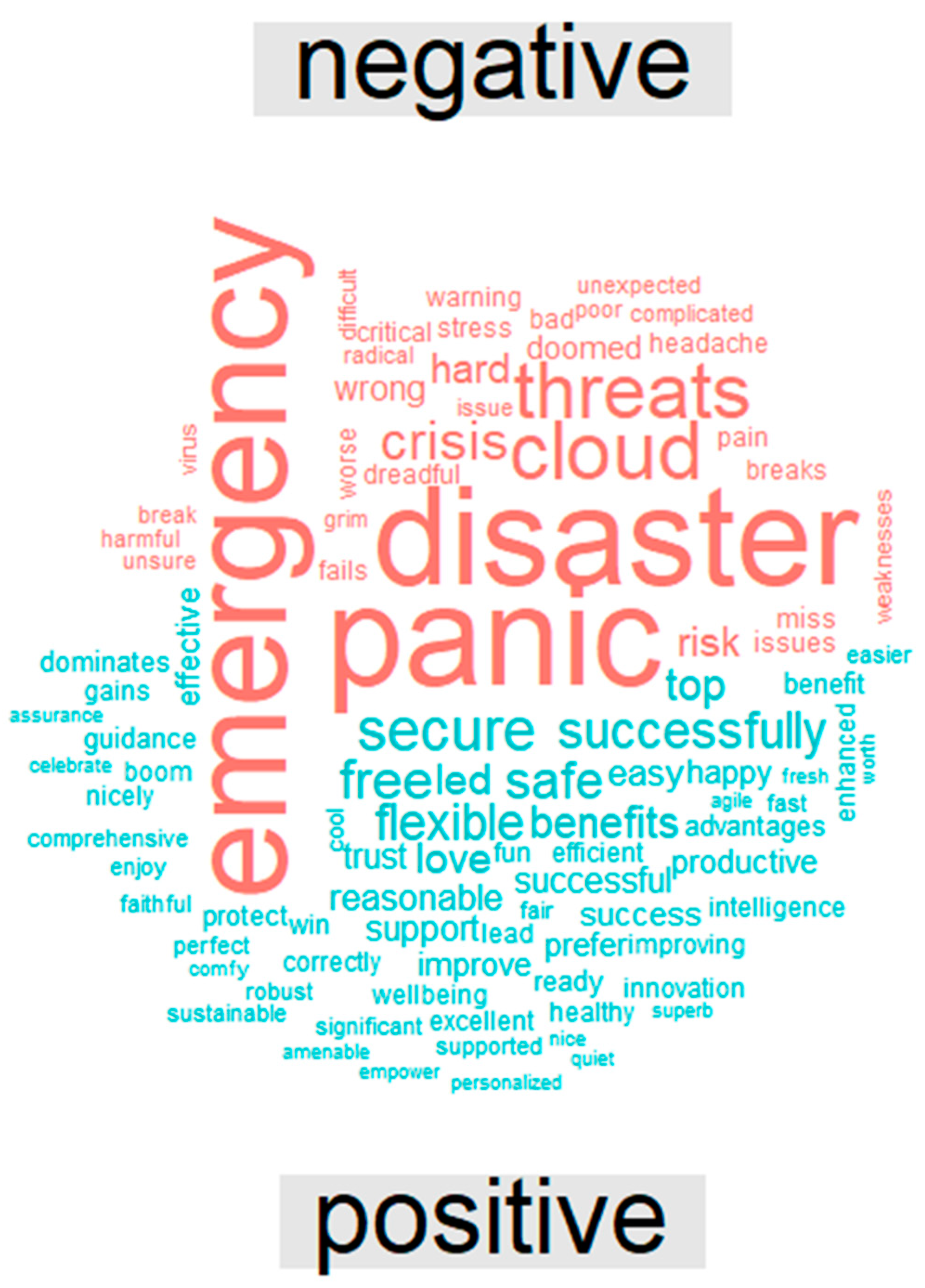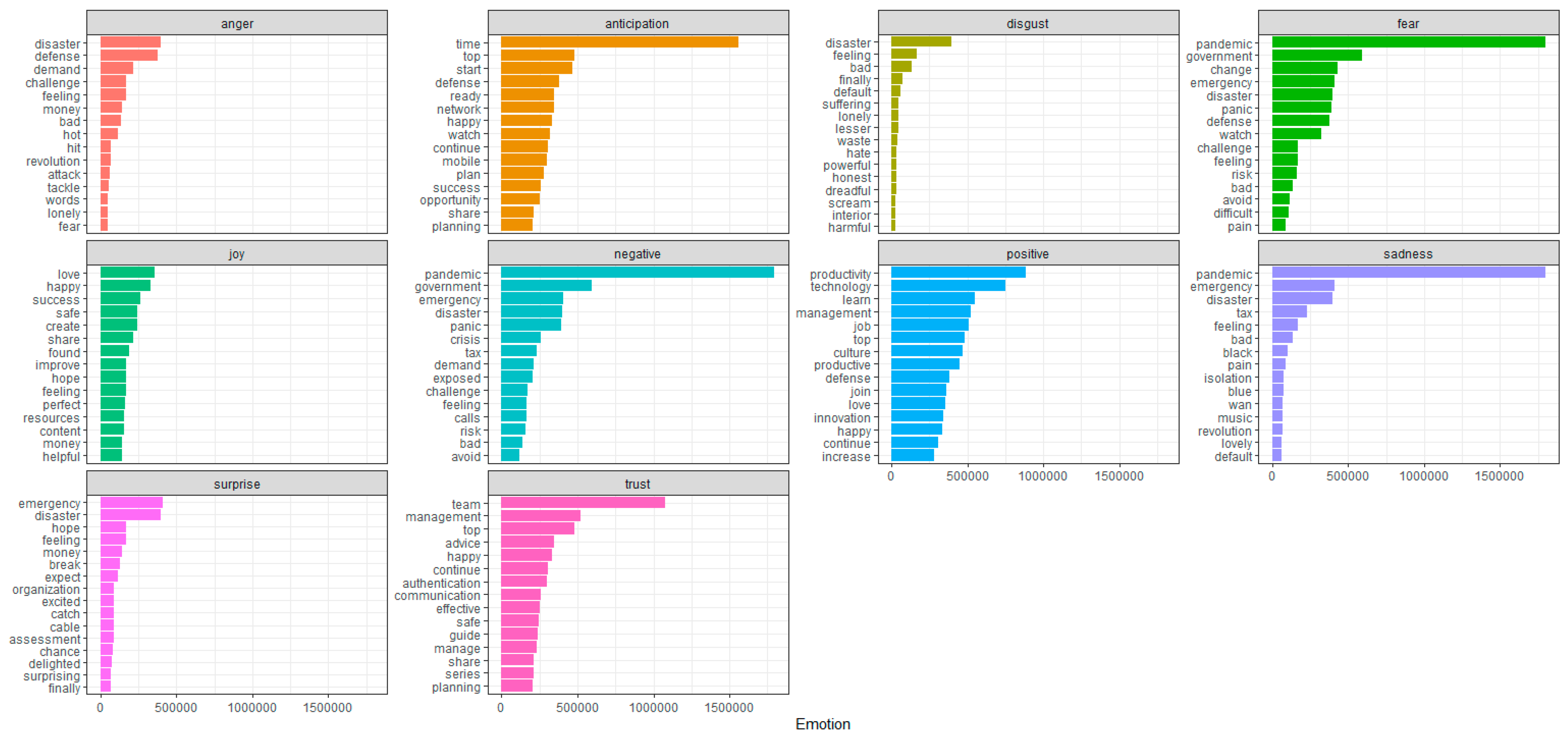Teleworking as an Eco-Innovation for Sustainable Development: Assessing Collective Perceptions during COVID-19
Abstract
1. Introduction
2. Literature Review
2.1. Teleworking: Benefits and Pitfalls
2.2. Teleworking and Environmental Sustainability
3. Materials and Methods
- Data Access: by means of TwitteR package, twitter messages are collected by selecting specific keywords;
- Data Cleaning: by means of additional packages, data is cleaned by removing stop (nonfunctional) words, spaces, punctuation, URLs and by performing stemming (namely, getting the root of the words). The output of this step is a structured representation of tweets called “Term-Document Matrix”.
- Data Analysis: the structured representation produced in the previous step allows for performing the mining process, such as finding more frequent terms and association rules, as well as performing sentiment analysis through the lexicon-based approach, which uses a set of positive and negative words and assigns a score to each tweet through a scoring function. The emotional content of the text is highlighted, by means of emotion lexicons, a list of English words associated with eight basic emotions (anger, fear, anticipation, trust, surprise, sadness, joy and disgust) and two sentiments (negative and positive) [60,61].
- Visualization: the word-cloud package and bar plots are showed in order to depict the frequency of words in the tweets collected and the sentiment and emotional scores.
4. Results
5. Discussion
5.1. Advantages of Teleworking and Sustainability
5.2. Disadvantages of Teleworking and Sustainability
6. Implication, Final Remarks and Conclusions
Author Contributions
Funding
Institutional Review Board Statement
Informed Consent Statement
Data Availability Statement
Conflicts of Interest
References
- Elldér, E. Telework and daily travel: New evidence from Sweden. J. Transp. Geogr. 2020, 86, 102777. [Google Scholar] [CrossRef]
- Wang, K.; Ozbilen, B. Synergistic and threshold effects of telework and residential location choice on travel time allocation. Sustain. Cities Soc. 2020, 63, 102468. [Google Scholar] [CrossRef]
- Belzunegui-Eraso, A.; Erro-Garcés, A. Teleworking in the Context of the Covid-19 Crisis. Sustainability 2020, 12, 3662. [Google Scholar] [CrossRef]
- Oltra, V.; Jean, M.S. Sectoral systems of environmental innovation: An application to the French automotive industry. Technol. Forecast. Soc. Chang. 2009, 76, 567–583. [Google Scholar] [CrossRef]
- Alos-Simo, L.; Verdu-Jover, A.J.; Gomez-Gras, J.M. Does activity sector matter for the relationship between eco-innovation and performance? Implications for cleaner production. J. Clean. Prod. 2020, 263, 121544. [Google Scholar] [CrossRef]
- Ghisetti, C.; Marzucchi, A.; Montresor, S. The open eco-innovation mode. An empirical investigation of eleven European countries. Res. Policy 2015, 44, 1080–1093. [Google Scholar] [CrossRef]
- Santos-Vijande, M.L.; Álvarez-González, L.I. Innovativeness and organizational innovation in total quality oriented firms: The moderating role of market turbulence. Technovation 2007, 27, 514–532. [Google Scholar] [CrossRef]
- Bigliardi, B.; Bertolini, M.; Doran, J.; Ryan, G. Regulation and firm perception, eco-innovation and firm performance. Eur. J. Innov. Manag. 2012, 15, 421–441. [Google Scholar]
- Eiadat, Y.; Kelly, A.; Roche, F.; Eyadat, H. Green and competitive? An empirical test of the mediating role of environmental innovation strategy. J. World Bus. 2008, 43, 131–145. [Google Scholar] [CrossRef]
- Sandberg, J.; Targama, A. Shared understanding: The basis for collective competences and its development. In Managing Un-derstanding in Organizations; SAGE: London, UK, 2007; pp. 89–108. [Google Scholar]
- Baruch, Y. Teleworking: Benefits and pitfalls as perceived by professionals and managers. New Technol. Work. Employ. 2000, 15, 34–49. [Google Scholar] [CrossRef]
- Illegems, V.; Verbeke, A.; S’Jegers, R. The organizational context of teleworking implementation. Technol. Forecast. Soc. Chang. 2001, 68, 275–291. [Google Scholar] [CrossRef]
- Coenen, M.; Kok, R.A. Workplace flexibility and new product development performance: The role of telework and flexible work schedules. Eur. Manag. J. 2014, 32, 564–576. [Google Scholar] [CrossRef]
- Gálvez, A.; Tirado, F.; Martínez, M.J. Work–Life Balance, Organizations and Social Sustainability: Analyzing Female Telework in Spain. Sustainability 2020, 12, 3567. [Google Scholar] [CrossRef]
- Baruch, Y. The status of research on teleworking and an agenda for future research. Int. J. Manag. Rev. 2001, 3, 113–129. [Google Scholar] [CrossRef]
- López-Igual, P.; Rodríguez-Modroño, P. Who is Teleworking and Where from? Exploring the Main Determinants of Telework in Europe. Sustainability 2020, 12, 8797. [Google Scholar] [CrossRef]
- Nilles, J. Telecommunications and Organizational Decentralization. Ieee Trans. Commun. 1975, 23, 1142–1147. [Google Scholar] [CrossRef]
- Pratt, J.H. Home teleworking: A study of its pioneers. Technol. Forecast. Soc. Chang. 1984, 25, 1–14. [Google Scholar] [CrossRef]
- Davenport, T.H.; Pearlson, K. Two cheers for the virtual office. Mit Sloan Manag. Rev. 1998, 39, 51. [Google Scholar]
- Morgan, R.E. Teleworking: An assessment of the benefits and challenges. Eur. Bus. Rev. 2004, 16, 344–357. [Google Scholar] [CrossRef]
- Torten, R.; Reaiche, C.; Caraballo, E.L. Teleworking in the new milleneum. J. Dev. Areas 2016, 50, 317–326. [Google Scholar] [CrossRef]
- Jones, J.C. Automation and design (1–5). Design 1957, 103, 104–106. [Google Scholar]
- Kelly, M.M. Next workplace revolution: Telecommuting. Superv. Manag. 1985, 30, 2–7. [Google Scholar]
- Watad, M.M.; DiSanzo, F.J. Case study: The synergism of telecommuting and office automation. Mit Sloan Manag. Rev. 2000, 41, 85. [Google Scholar]
- Drucker, P.F. Knowledge-Worker Productivity: The Biggest Challenge. Calif. Manag. Rev. 1999, 41, 79–94. [Google Scholar] [CrossRef]
- Peiperl, M.; Baruch, Y. Back to square zero: The post-corporate career. Organ. Dyn. 1997, 25, 7–22. [Google Scholar] [CrossRef]
- Handy, S.L.; Mokhtarian, P.L. The future of telecommuting. Futures 1996, 28, 227–240. [Google Scholar] [CrossRef]
- Dima, A.-M.; Țuclea, C.-E.; Vrânceanu, D.-M.; Țigu, G. Sustainable Social and Individual Implications of Telework: A New Insight into the Romanian Labor Market. Sustainability 2019, 11, 3506. [Google Scholar] [CrossRef]
- Fonner, K.L.; Roloff, M.E. Why Teleworkers are More Satisfied with Their Jobs than are Office-Based Workers: When Less Contact is Beneficial. J. Appl. Commun. Res. 2010, 38, 336–361. [Google Scholar] [CrossRef]
- Venkatesh, V.; Speier, C. Creating an effective training environment for enhancing telework. Int. J. Hum. Comput. Stud. 2000, 52, 991–1005. [Google Scholar] [CrossRef]
- Toscano, F.; Zappalà, S. Social Isolation and Stress as Predictors of Productivity Perception and Remote Work Satisfaction during the COVID-19 Pandemic: The Role of Concern about the Virus in a Moderated Double Mediation. Sustainability 2020, 12, 9804. [Google Scholar] [CrossRef]
- Duxbury, L.E.; Higgins, C.A.; Mills, S. After-Hours Telecommuting and Work-Family Conflict: A Comparative Analysis. Inf. Syst. Res. 1992, 3, 173–190. [Google Scholar] [CrossRef]
- Adams, G.A.; King, L.A.; King, D.W. Relationships of job and family involvement, family social support, and work–family conflict with job and life satisfaction. J. Appl. Psychol. 1996, 81, 411. [Google Scholar] [CrossRef]
- Golden, T.D. Avoiding depletion in virtual work: Telework and the intervening impact of work exhaustion on commitment and turnover intentions. J. Vocat. Behav. 2006, 69, 176–187. [Google Scholar] [CrossRef]
- Madsen, S.R. The effects of home-based teleworking on work-family conflict. Hum. Resour. Dev. Q. 2003, 14, 35–58. [Google Scholar] [CrossRef]
- Suh, A.; Lee, J. Understanding teleworkers’ technostress and its influence on job satisfaction. Internet Res. 2017, 27, 140–159. [Google Scholar] [CrossRef]
- Tarafdar, M.; Tu, Q.; Ragu-Nathan, T.S. Impact of Technostress on End-User Satisfaction and Performance. J. Manag. Inf. Syst. 2010, 27, 303–334. [Google Scholar] [CrossRef]
- Haddon, L. The experience of teleworking: A view from the home. In Teleworking: New International Perspectives from Tele-commuting to the Virtual Organisation; Jackson, P.J., van der Wielen, J.M., Eds.; Routledge: London, UK, 1998. [Google Scholar]
- Missimer, M.; Robèrt, K.-H.; Broman, G. A strategic approach to social sustainability—Part 1: Exploring the social system. J. Clean. Prod. 2017, 140, 32–41. [Google Scholar] [CrossRef]
- Harpaz, I. Advantages and disadvantages of telecommuting for the individual, organization and society. Work. Study 2002, 51, 74–80. [Google Scholar] [CrossRef]
- Mekonnen, M.M.; Pahlow, M.; Aldaya, M.M.; Zarate, E.; Hoekstra, A.Y. Sustainability, Efficiency and Equitability of Water Consumption and Pollution in Latin America and the Caribbean. Sustainability 2015, 7, 2086–2112. [Google Scholar] [CrossRef]
- Lundgren, K.; Kjellstrom, T. Sustainability Challenges from Climate Change and Air Conditioning Use in Urban Areas. Sustainability 2013, 5, 3116–3128. [Google Scholar] [CrossRef]
- Zaharia, A.; Diaconeasa, M.C.; Brad, L.; Lădaru, G.-R.; Ioanăș, C. Factors Influencing Energy Consumption in the Context of Sustainable Development. Sustainability 2019, 11, 4147. [Google Scholar] [CrossRef]
- Mello, J.A. Managing Telework Programs Effectively. Empl. Responsib. Rights J. 2007, 19, 247–261. [Google Scholar] [CrossRef]
- Pérez, M.P.; Sánchez, A.M.; Carnicer, M.P.D.L.; Jiménez, M.J.V. The environmental impacts of teleworking. Manag. Environ. Qual. Int. J. 2004, 15, 656–671. [Google Scholar] [CrossRef]
- Hook, A.; Court, V.; Sovacool, B.K.; Sorrell, S. A systematic review of the energy and climate impacts of teleworking. Environ. Res. Lett. 2020, 15, 093003. [Google Scholar] [CrossRef]
- WHO (World Health Organization). WHO Director-General’s Opening Remarks at the Media Briefing on COVID-19, 11 March 2020; WHO: Geneva, Switzerland, 2020. [Google Scholar]
- Lin, Y. 10 twitter statistics every marketer should know in 2021. 2021. Available online: https://www.oberlo.com/blog/twitter-statistics#:~:text=Here’s%20a%20summary%20of%20the,are%20between%2035%20and%2065Retrived01/03/2021 (accessed on 2 March 2021).
- Merle, M.; Reese, G.; Drews, S. Globalcitizen: An explorative twitter analysis of global identity and sustainability commu-nication. Sustainability 2019, 11, 3472. [Google Scholar] [CrossRef]
- Pilař, L.; Stanislavská, L.K.; Pitrová, J.; Krejčí, I.; Tichá, I.; Chalupová, M. Twitter Analysis of Global Communication in the Field of Sustainability. Sustainability 2019, 11, 6958. [Google Scholar] [CrossRef]
- BBC News. Covid-19: Global coronavirus cases pass 50 million. 2020. Available online: https://www.bbc.com/news/world-54867793 (accessed on 9 November 2020).
- Hailong, Z.; Wenyan, G.; Bo, J. Machine learning and lexicon based methods for sentiment classification: A survey. In 2014 11th web information system and application conference. IEEE 2014, 9, 262–265. [Google Scholar]
- Miner, G.; Elder IV, J.; Fast, A.; Hill, T.; Nisbet, R.; Delen, D. Practical Text Mining and Statistical Analysis for Non-Structured Text Data Applications; Academic Press: London, UK, 2012. [Google Scholar]
- Gentry, J. Twitter client for R. 2013. Available online: https://cran.r-project.org/web/packages/twitteR/twitteR.pdf (accessed on 2 March 2021).
- KDnuggets.com. What Analytics, Data Mining, Big Data Software You Used in the Past 12 Months for a Real Project? 2012. Available online: http://www.kdnuggets.com/polls/2012/analytics-data-mining-big-data-software.html (accessed on 2 March 2021).
- Tsur, O.; Rappoport, A. What’s in a Hashtag? Content Based Prediction of the Spread of Ideas in Microblogging Communities. In Proceedings of the Fifth ACM International Conference on Web Search and Data Mining, Seattle, WA, USA, 8–12 February 2012; pp. 643–652. [Google Scholar]
- Menshikova, M.; Fedorova, A.; Gatti, M. Introducing Smart-Working in the Conditions of Digital Business Transformation: Analysis of an Employee’s Experience. In Lecture Notes in Information Systems and Organisation; Metzler, J.B., Ed.; Springer: Berlin, Germany, 2020; pp. 59–71. [Google Scholar]
- Torre, T.; Sarti, D. Themes and Trends in Smart Working Research: A Systematic Analysis of Academic Contributions. Indig. Afr. Enterp. 2019, 23, 177–200. [Google Scholar]
- Younis, E.M. Sentiment analysis and text mining for social media microblogs using open source tools: An empirical study. Int. J. Comput. Appl. 2015, 5, 112. [Google Scholar]
- Mohammad, S.M.; Turney, P.D. Crowdsourcing a word-emotion association lexicon. Comput. Intell. 2012, 29, 436–465. [Google Scholar] [CrossRef]
- Hu, M.; Liu, B. Mining and summarizing customer reviews. In Proceedings of the Proceedings of the 2004 ACM SIGKDD international conference on Knowledge discovery and data mining–KDD ’04; ACM: New York, NY, USA, 2004; pp. 168–177. [Google Scholar]
- Saini, S.; Punhani, R.; Bathla, R.; Shukla, V.K. Sentiment Analysis on Twitter Data using R. In Proceedings of the 2019 International Conference on Automation, Computational and Technology Management (ICACTM), London, UK, 24–26 April 2019; pp. 68–72. [Google Scholar]
- 2020 Sentio Solutions. Our Emotions Are Changing during the Covid-19 Pandemic 2020. Available online: https://uploads-ssl.webflow.com/596c68356dc5b2598b09b912/5eb3cfae67bd4c51e0cfe1a4_COVID%20-19%20STUDY%20by%20Feel.pdf (accessed on 2 March 2021).
- Restubog, S.L.D.; Ocampo, A.C.G.; Wang, L. Taking control amidst the chaos: Emotion regulation during the COVID-19 pandemic. J. Vocat. Behav. 2020, 119, 103440. [Google Scholar] [CrossRef] [PubMed]
- Wang, K.; Goldenberg, A.; Dorison, C.; Miller, J.; Lerner, J.; Gross, J.; A Global Test of Brief Reappraisal Interventions on Emo-Tions during the COVID-19 Pandemic. Leibniz Institut für Psychologische Information und Dokumentation (ZPID). 2020. Available online: https://pubmed.ncbi.nlm.nih.gov/33415997/ (accessed on 10 March 2021).
- Manucci, M. How People Come Back to Workplaces during the Pandemic: Three dimensions of intervention for new emotional performance conditions. Hum. Resour. Dev. Int. 2021, 1–8. [Google Scholar] [CrossRef]
- Contreras, F.; Baykal, E.; Abid, G. E-Leadership and Teleworking in Times of COVID-19 and Beyond: What We Know and Where Do We Go. Front. Psychol. 2020, 11, 590271. [Google Scholar] [CrossRef]
- Cartmill, C. New Survey Shows 87% of Staff Wish to Work from Home in Post Lockdown World; Belfast News Letter: Belfast, North Ireland, 2020. [Google Scholar]
- Gálvez, A.; Tirado, F.; Alcaraz, J.M. “Oh! Teleworking!” Regimes of engagement and the lived experience of female Spanish teleworkers. Bus. Ethic A Eur. Rev. 2019, 29, 180–192. [Google Scholar] [CrossRef]
- Eizenberg, E.; Jabareen, Y. Social Sustainability: A New Conceptual Framework. Sustainability 2017, 9, 68. [Google Scholar] [CrossRef]
- Schall, M.C., Jr.; Chen, P.; Evidence-Based Strategies for Improving Occupational Safety and Health among Teleworkers during and after the Coronavirus Pandemic. Human Factors; SAGE Publishing. 2021. Available online: https://www.psycharchives.org/handle/20.500.12034/2577 (accessed on 10 March 2021).
- Blake-Beard, S.; O’Neill, R.; Ingols, C.; Shapiro, M. Social sustainability, flexible work arrangements, and diverse women. Gend. Manag. Int. J. 2010, 25, 408–425. [Google Scholar] [CrossRef]
- Sánchez, A.M.; Pérez, M.P.; Carnicer, P.D.L.; Jiménez, M.J.V. Teleworking and workplace flexibility: A study of impact on firm performance. Pers. Rev. 2007, 36, 42–64. [Google Scholar] [CrossRef]
- Dujon, V.; Dillard, J.; Brennan, E.M. (Eds.) Social Sustainability: A Multilevel Approach to Social Inclusion; Routledge: London, UK, 2013. [Google Scholar]
- Schur, L.A.; Ameri, M.; Kruse, D. Telework after COVID: A “silver lining” for workers with disabilities? J. Occup. Rehabil. 2020, 30, 521–536. [Google Scholar] [CrossRef] [PubMed]
- Hamouche, S. COVID-19 and employees’ mental health: Stressors, moderators and agenda for organizational actions. Emerald Open Res. 2020, 2, 15. [Google Scholar] [CrossRef]
- Rogers, D.S.; Duraiappah, A.K.; Antons, D.C.; Munoz, P.; Bai, X.; Fragkias, M.; Gutscher, H. A vision for human well-being: Transition to social sustainability. Curr. Opin. Environ. Sustain. 2012, 4, 61–73. [Google Scholar] [CrossRef]
- Bérard, E.; Kai, S.H.Y.; Coley, N.; Bongard, V.; Ferrières, J. Lockdown-related factors associated with the worsening of car-diovascular risk and anxiety or depression during the COVID-19 pandemic. Prev. Med. Rep. 2021, 21, 101300. [Google Scholar] [CrossRef]
- Peretti-Watel, P.; Alleaume, C.; Léger, D.; Beck, F.; Verger, P. Anxiety, depression and sleep problems: A second wave of COVID-19. Gen. Psychiatry 2020, 33, e100299. [Google Scholar] [CrossRef] [PubMed]
- Mushfiqur, R.; Mordi, C.; Oruh, E.S.; Nwagbara, U.; Mordi, T.; Turner, I.M. The impacts of work-life-balance (WLB) challenges on social sustainability. Empl. Relat. 2018, 40, 868–888. [Google Scholar] [CrossRef]
- Boyer, R.H.W.; Peterson, N.D.; Arora, P.; Caldwell, K. Five Approaches to Social Sustainability and an Integrated Way Forward. Sustainability 2016, 8, 878. [Google Scholar] [CrossRef]
- Ahmed, E.M. Modelling Information and Communications Technology Cyber Security Externalities Spillover Effects on Sustainable Economic Growth. J. Knowl. Econ. 2021, 12, 412–430. [Google Scholar] [CrossRef]
- Abukari, A.M.; Bankas, E.K. Some cyber security hygienic protocols for teleworkers in COVID-19 pandemic period and beyond. Int. J. Sci. Eng. Res. 2020, 11, 1401–1407. [Google Scholar]
- Fedulova, I.; Voronkova, O.; Zhuravlev, P.; Gerasimova, E.; Glyzina, M.; Alekhina, N. Labor productivity and its role in the sustainable development of economy: On the example of a region. Entrep. Sustain. Issues 2019, 7, 1059–1073. [Google Scholar] [CrossRef]
- Reina, R.; Scarozza, D. Human Resource Management in the Public Administration. In Organizational Development in Public Administration; Decastri, M., Battini, S., Buonocore, F., Gagliarducci, F., Eds.; Palgrave Macmillan: London, UK, 2021; pp. 61–101. [Google Scholar]
- Torre, T.; Sarti, D. Into Smart Work Practices: Which Challenges for the HR Department? In Working in Digital and Smart Organizations; Ales, E., Curzi, Y., Fabbri, T., Rymkevich, O., Senatori, I., Solinas, G., Eds.; Palgrave Macmillan: London, UK, 2018; pp. 249–275. [Google Scholar]



| Ranking | Positive Impact on Sustainable Development | Positive Concepts | Sub-Concepts |
|---|---|---|---|
| 1st | Social sustainability | Occupational safety and health | Safe Safety Wellbeing Secure Privilege |
| 2nd | Social sustainability | Flexible working organization | Free Flexible Smart Smarter Agile |
| 3rd | Economic sustainability | Performance management | Top Productive Success Successfully Effective Effectively Easy Enhance Talent Improve |
| 4th | Social sustainability | Employee’s engagement | Innovation Enjoy Trust Happy Love Engaging Prefer |
| 5th | Social sustainability | Social inclusion | Inclusion |
| Ranking | Negative Impact on Sustainable Development | Negative Concepts | Sub-Concepts |
|---|---|---|---|
| 1st | Social sustainability | Depression and mental health | Panic Crisis Degradation Disruption Pain Worry Twisted Cry |
| 2nd | Economic sustainability | Digital and cyber security | Cloud Risk Attack Fraud |
| 3nd | Social sustainability | Performance management | Hard Issues Difficult Stress Deaf Noise Doomed |
| 4th | Social sustainability | Lack of work-life balance | Overlook Concern Tired |
| 5th | Social sustainability | Isolation from organization/social relations | Miss Missed Losing Loneliness Lonely Isolation Clash |
| 6th | Economic sustainability | Lost productivity | Lazy Slow Disrupt Disruption Slack |
Publisher’s Note: MDPI stays neutral with regard to jurisdictional claims in published maps and institutional affiliations. |
© 2021 by the authors. Licensee MDPI, Basel, Switzerland. This article is an open access article distributed under the terms and conditions of the Creative Commons Attribution (CC BY) license (https://creativecommons.org/licenses/by/4.0/).
Share and Cite
Loia, F.; Adinolfi, P. Teleworking as an Eco-Innovation for Sustainable Development: Assessing Collective Perceptions during COVID-19. Sustainability 2021, 13, 4823. https://doi.org/10.3390/su13094823
Loia F, Adinolfi P. Teleworking as an Eco-Innovation for Sustainable Development: Assessing Collective Perceptions during COVID-19. Sustainability. 2021; 13(9):4823. https://doi.org/10.3390/su13094823
Chicago/Turabian StyleLoia, Francesca, and Paola Adinolfi. 2021. "Teleworking as an Eco-Innovation for Sustainable Development: Assessing Collective Perceptions during COVID-19" Sustainability 13, no. 9: 4823. https://doi.org/10.3390/su13094823
APA StyleLoia, F., & Adinolfi, P. (2021). Teleworking as an Eco-Innovation for Sustainable Development: Assessing Collective Perceptions during COVID-19. Sustainability, 13(9), 4823. https://doi.org/10.3390/su13094823







